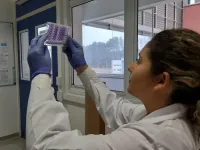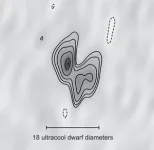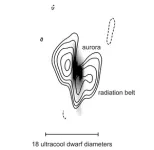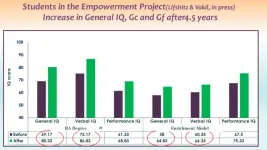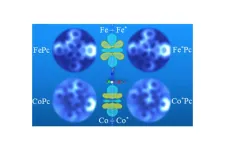(Press-News.org) Resistance to antibiotics is a problem that alarms the medical and scientific community. Bacteria resistant to three different classes of antibiotics, known as multi-drug resistant (MDR) bacteria, are far from rare. Some are even resistant to all currently available treatments and are known as pan-drug resistant (PDR). They are associated with dangerous infections and listed by the World Health Organization (WHO) as priority pathogens for drug development with maximum urgency.
An article published in a special issue of the journal Antibiotics highlights a compound with antibacterial activity that presented promising results within one hour in laboratory trials.
The study was led by Ilana Camargo, last author of the article, and conducted during the doctoral research of first author Gabriela Righetto at the Molecular Epidemiology and Microbiology Laboratory (LEMiMo) of the University of São Paulo’s São Carlos Institute of Physics (IFSC-USP) in Brazil.
“The compound we discovered is a new peptide, Pln149-PEP20, with a molecular framework designed to enhance its antimicrobial activity and with low toxicity. The results can be considered promising insofar as the trials involved pathogenic bacteria associated with MDR infections worldwide,” said Adriano Andricopulo, a co-author of the article.
Although novel antibacterial drugs are urgently needed, the pharmaceutical industry is notoriously uninterested in pursuing them, mainly because research in this field is time-consuming and costly, requiring very long lead times to bring viable active compounds to market.
The Center for Innovation in Biodiversity and Drug Discovery (CIBFar), a Research, Innovation and Dissemination Center (RIDC) set up and funded by FAPESP, looks for molecules that can be used to combat multidrug-resistant bacteria.
Camargo and Andricopulo are researchers at CIBFar, as are two other co-authors who study promising bactericidal compounds: Leila Beltramini and José Luiz Lopes.
For over a decade, the group formed by the collaboration between Beltramini and Lopes has analyzed Plantaricin 149 and its analogs. Plantaricins are substances produced by the bacterium Lactobacillus plantarum to combat other bacteria.
Lactobacillus plantarum is commonly found in nature, especially in anaerobic plant matter, and in many fermented vegetable, meat and dairy products.
In the case of Plantaricin 149, Japanese researchers were the first to report its bactericidal action (in 1994) and since then scientists have been interested in obtaining more efficient synthetic analogs (molecules with small structural differences). In 2007, one of the first projects completed by the CIBFar team showed that the peptide inhibits pathogenic bacteria such as Listeria spp. and Staphylococcus spp. They then began studying synthetic analogs with stronger bactericidal activity than the original (causing more damage to the membrane of the combated microorganisms).
With the support of a scholarship from FAPESP, Righetto synthesized 20 analogs of Plantaricin 149, finding that Pln149-PEP20 had the best results so far and was also half the size of the original peptide. “The main advances in our research consist of the development of this smaller, more active and less toxic molecule, and the characterization of its action and propensity to develop resistance. It has proven to be highly promising in vitro – active against MDR bacteria and extensively resistant bacteria,” said Camargo, principal investigator for the project.
LEMiMo, the laboratory where the studies were conducted, has experience in characterizing bacterial isolates involved in outbreaks of hospital infections and holds a collection of bacteria selected for these trials in search of novel active compounds. The bacteria have the resistance profiles currently of greatest concern and were isolated during hospital outbreaks.
They are known in the scientific community by the term ESKAPE, an acronym for the scientific names of six highly virulent and antibiotic-resistant bacterial pathogens: Enterococcus faecium, Staphylococcus aureus, Klebsiella pneumoniae, Acinetobacter baumannii, Pseudomonas aeruginosa, and Enterobacter spp.
Further research can now be conducted to investigate the molecule’s action mechanism in more depth, to look for formulations, and possibly to develop an application. “In terms of the action mechanism, it’s also possible to use the cell morphology of the bacteria to identify cellular pathways affected by the peptide,” Righetto said. “As for optimization, the molecule can be functionalized by being linked to macrostructures, and the amino acid sequence can be modified.” Research is also needed on its cytotoxicity and on its selectivity (whether it affects healthy cells).
“We’re living in times of major global public health hazards due to a lack of antimicrobials that can be used to treat infections caused by extremely resistant bacteria. Antimicrobial peptides are targets of great interest for the development of novel candidate drugs. This novel molecule has the potential to be used as an innovative antimicrobial therapy, but further modifications and molecular optimizations still need to be investigated,” Andricopulo said.
Publication of the article also involved Harvard Medical School’s Infectious Disease Institute in Boston (USA) via researchers Paulo José Martins Bispo and Camille André.
About São Paulo Research Foundation (FAPESP)
The São Paulo Research Foundation (FAPESP) is a public institution with the mission of supporting scientific research in all fields of knowledge by awarding scholarships, fellowships and grants to investigators linked with higher education and research institutions in the State of São Paulo, Brazil. FAPESP is aware that the very best research can only be done by working with the best researchers internationally. Therefore, it has established partnerships with funding agencies, higher education, private companies, and research organizations in other countries known for the quality of their research and has been encouraging scientists funded by its grants to further develop their international collaboration. You can learn more about FAPESP at www.fapesp.br/en and visit FAPESP news agency at www.agencia.fapesp.br/en to keep updated with the latest scientific breakthroughs FAPESP helps achieve through its many programs, awards and research centers. You may also subscribe to FAPESP news agency at http://agencia.fapesp.br/subscribe.
END
Researchers find compound that combats multidrug-resistant bacteria in less than one hour
In vitro experiments were conducted at a FAPESP-supported research center with a synthetic peptide inspired by molecules secreted by the probiotic bacterium Lactobacillus plantarum
2023-05-15
ELSE PRESS RELEASES FROM THIS DATE:
Postsecondary university education improves intelligence of adult students with intellectual disability
2023-05-15
Post-secondary education (PSE) has a potential for improving the IQ of adults with mild intellectual disability (ID), according to a new Bar-Ilan University study.
The study examined the impact of PSE on students with mild ID who study in a university-based program, known as the Empowerment Project, at the Bar-Ilan University Faculty of Education.
The study sample included 24 participants, divided into 12 students with ID who participate in the Empowerment Project and 12 adults with ID with the same background, who did not participate. The results were published in the European Journal of Special Needs Education.
The findings revealed significant IQ improvement ...
With formic acid towards CO2 neutrality
2023-05-15
New synthetic metabolic pathways for fixation of carbon dioxide could not only help to reduce the carbon dioxide content of the atmosphere, but also replace conventional chemical manufacturing processes for pharmaceuticals and active ingredients with carbon-neutral, biological processes. A new study demonstrates a process that can turn carbon dioxide into a valuable material for the biochemical industry via formic acid.
In view of rising greenhouse gas emissions, carbon capture, the sequestration of carbon dioxide from large emission sources, is an ...
Astronomers observe the first radiation belt seen outside of our solar system
2023-05-15
Astronomers have described the first radiation belt observed outside our solar system, using a coordinated array of 39 radio dishes from Hawaii to Germany to obtain high-resolution images. The images of persistent, intense radio emissions from an ultracool dwarf reveal the presence of a cloud of high-energy electrons trapped in the object’s powerful magnetic field, forming a double-lobed structure analogous to radio images of Jupiter’s radiation belts.
“We are actually imaging the magnetosphere of our target by observing the radio-emitting ...
New study reveals widespread presence of environmental DNA in the sky, including allergens and pathogens
2023-05-15
Recently published in PeerJ Life and Environment, researchers successfully use aircraft surveys with novel instrumentation to capture airborne nucleic acids and probe biodiversity in the atmosphere, uncovering surprising findings.
[Clemson, May 2023] - A groundbreaking research article titled "Aircraft Surveys for Air eDNA: Probing Biodiversity in the Sky" unveils a revolutionary approach to studying genetic material in the atmosphere. Scientists have developed a durable and sterilizable probe and supporting system to capture air environmental nucleic acids (eDNA) with full-flow filtration and a high-integrity chamber.
Using this innovative probe, ...
Tetris reveals how people respond to unfair AI
2023-05-15
ITHACA, N.Y. – A Cornell University-led experiment in which two people play a modified version of Tetris revealed that players who get fewer turns perceived the other player as less likable, regardless of whether a person or an algorithm allocated the turns.
Most studies on algorithmic fairness focus on the algorithm or the decision itself, but researchers sought to explore the relationships among the people affected by the decisions.
“We are starting to see a lot of situations in which AI makes decisions on how resources should be distributed among people,” ...
Distinct types of cerebellar neurons control motor and social behaviors
2023-05-15
The cerebellum, a major part of the hindbrain in all vertebrates, is important for motor coordination, language acquisition, and regulating social and emotional behaviors. A study led by Dr. Roy Sillitoe, professor of Pathology and Neuroscience at Baylor College of Medicine and investigator at the Jan and Dan Duncan Neurological Research Institute (Duncan NRI) at Texas Children’s Hospital, shows two distinct types of cerebellar neurons differentially regulate motor and non-motor behaviors during development and in adulthood.
The study, published in Nature Communications, provides the first in ...
Seeing electron orbital signatures
2023-05-15
No one will ever be able to see a purely mathematical construct such as a perfect sphere. But now, scientists using supercomputer simulations and atomic resolution microscopes have imaged the signatures of electron orbitals, which are defined by mathematical equations of quantum mechanics and predict where an atom’s electron is most likely to be.
Scientists at UT Austin, Princeton University, and ExxonMobil have directly observed the signatures of electron orbitals in two different transition-metal atoms, iron (Fe) and cobalt ...
Commercial investors shift perspective of coastal properties in face of climate change
2023-05-15
UNIVERSITY PARK, Pa. — Investors in commercial real estate are rethinking the values of coastal properties exposed to flood risk — even in northern U.S. locales that haven’t suffered flood damage, according to researchers. This shift in perspective has implications for investors and developers alike as they determine the value of coastal properties amid a changing climate.
Eva Steiner, associate professor of real estate and King Family Early Career Professor in Real Estate in the Penn State Smeal College of Business, and her co-authors published these findings recently in Real Estate Economics.
Steiner and ...
Luo to receive NSF funding for collaborative research: catholyte molecular design for non-aqueous mg-organic hybrid redox flow batteries
2023-05-15
Chao Luo, Assistant Professor, Chemistry and Biochemistry, is set to receive funding from the National Science Foundation for the project: "Collaborative Research: Catholyte Molecular Design For Non-Aqueous Mg-Organic Hybrid Redox Flow Batteries."
Luo is proposing a new organic molecule structure design concept for redox flow batteries, which are promising for grid-scale energy storage. The research outcomes will afford low-cost, abundant, sustainable, and high-performance organic catholyte materials for non-aqueous Mg-organic hybrid redox flow batteries.
His goal is to design, synthesize, and characterize core-shell ...
Huneke wins grant to research lesbians in the Third Reich
2023-05-15
Samuel Clowes Huneke, Assistant Professor, History and Art History, has been awarded a Sharon Abramson Research Grant from the Holocaust Educational Foundation of Northwestern University. The award will enable him to complete research for his forthcoming book on lesbians in Nazi Germany.
For many decades after the end of World War II, the fates of queer women were ignored. Because female homosexuality had not been criminalized explicitly, historians long argued that lesbians were not persecuted by the Nazi regime.
In contrast, Huneke’s book, which is under advanced contract with Aevo-University of Toronto Press, argues that queer women under Nazism faced ...
LAST 30 PRESS RELEASES:
Structure of dopamine-releasing neurons relates to the type of circuits they form for smell-processing
Reducing social isolation protects the brain in later life
Keeping the heart healthy increases longevity even after cancer
Young adults commonly mix cannabis with nicotine and tobacco
Comprehensive review illuminates tau protein's dual nature in brain health, disease, and emerging psychiatric connections
Book prepares K-12 leaders for the next public health crisis
Storms in the Southern Ocean mitigates global warming
Seals on the move: Research reveals key data for offshore development and international ecology
Sports injuries sustained during your period might be more severe
World's first successful 2 Tbit/s free-space optical communication using small optical terminals mountable on satellites and HAPS
Can intimate relationships affect your heart? New study says ‘yes’
Scalable and healable gradient textiles for multi‑scenario radiative cooling via bicomponent blow spinning
Research shows informed traders never let a good climate crisis go to waste
Intelligent XGBoost framework enhances asphalt pavement skid resistance assessment
Dual-function biomaterials for postoperative osteosarcoma: Tumor suppression and bone regeneration
New framework reveals where transport emissions concentrate in Singapore
NTP-enhanced lattice oxygen activation in Ce-Co catalysts for low-temperature soot combustion
Synergistic interface engineering in Cu-Zn-Ce catalysts for efficient CO2 hydrogenation to methanol
COVID-19 leaves a lasting mark on the human brain
Scientists use ultrasound to soften and treat cancer tumors without damaging healthy tissue
Community swimming program for Black youth boosts skills, sense of belonging, study finds
Specific depressive symptoms in midlife linked to increased dementia risk
An ‘illuminating’ design sheds light on cholesterol
Who is more likely to get long COVID?
Study showcases resilience and rapid growth of “living rocks”
Naval Research Lab diver earns Office of Naval Research 2025 Sailor of the Year
New Mayo-led study establishes practical definition for rapidly progressive dementia
Fossil fuel industry’s “climate false solutions” reinforce its power and aggravate environmental injustice
Researchers reveal bias in a widely used measure of algorithm performance
Alcohol causes cancer. A study from IOCB Prague confirms damage to DNA and shows how cells defend against it
[Press-News.org] Researchers find compound that combats multidrug-resistant bacteria in less than one hourIn vitro experiments were conducted at a FAPESP-supported research center with a synthetic peptide inspired by molecules secreted by the probiotic bacterium Lactobacillus plantarum
